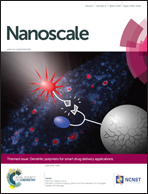Tuning upconversion through a sensitizer/activator-isolated NaYF4 core/shell structure†
Abstract
The ability to tune the emission color of upconversion nanoparticles (UCNPs) will greatly enhance the scope of their applications, ranging from infrared solar cells to volumetric multiplexed bioimaging. Conventional methods to tune upconversion are to vary the type and/or the concentration of doped rare-earth ions in these nanoparticle formulations. Here, we introduce a different approach to vary the emission colors of the frequently used sensitizer/activator pairs of Yb3+/RE3+ (RE = Ho, Er, Tm) via utilization of a sensitizer/activator-isolated NaYF4 core–shell structure. We show that the typical green, yellow, and blue luminescent colors from Yb3+/Ho3+-, Yb3+/Er3+-, and Yb3+/Tm3+-co-doped NaYF4 UCNPs can be converted into the quasi-white, green, and pink blue, when corresponding core–shell structures of NaYF4:Yb3+ @NaYF4:Ho3+, NaYF4:Yb3+ @NaYF4:Er3+ and NaYF4:Yb3+ @NaYF4:Tm3+ are built. Time-resolved spectra indicate that decay lifetimes of the emission bands from the sensitizer/activator-isolated core–shell structure significantly vary from that of the sensitizer/activator-codoped NaYF4 UCNPs, verifying the strain-induced modulation of emission channels in the core–shell structure. These sensitizer-activator-isolated core–shell UCNPs have implications for a range of biophotonic or photonic applications.


 Please wait while we load your content...
Please wait while we load your content...